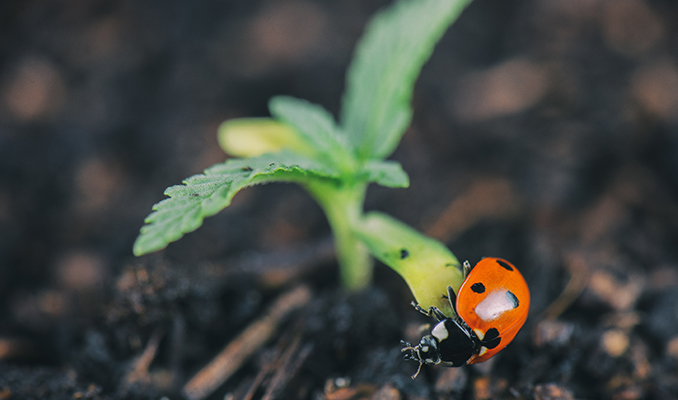Organic Pest Control Methods For Cannabis Plants
Published :
Sep 8, 2018
Categories :
Other subjects

Organic pest control features methods such as foliar sprays, predatory insects, and companion planting in order to defend cannabis crops against insect pests.
Cannabis has been proven to be a highly effective herbal medicine, so it seems quite counterintuitive to douse this healing plant in chemical pesticides that are harmful to human health. These chemicals don’t stay within their targeted zones either; elements such as wind and water carry these nefarious chemicals out into the environment where they can do some serious damage to vital insect populations.
Fortunately, awareness surrounding the negative effects of pesticide use is growing, with increasing demand for organic and beyond-organic methods of cannabis cultivation. Organic cultivators have developed synergistic and environmentally-oriented methods to deal with pests, without damaging the environment and contaminating their herbs with chemicals.
WHAT IS BIOLOGICAL PEST CONTROL?
Biological pest control is an umbrella term that encompasses various means of dealing with pests that have an appetite for cannabis, without the use of synthetic chemicals. This school of thought utilises tools such as predatory insects and plant extracts to eliminate pests that would otherwise reduce yields and damage plant vigour.
Biological pest control has some serious advantages over conventional means of growing with pesticides. Biological controls cause no damage to plants and leave behind no dangerous residues. Additionally, pests do not develop a resistance over time as their natural predators are used to counter them. Biological controls actually have a wider scope of use than pesticides and can be used in situations where pesticides cannot, such as on companion plants that do not have specific synthetic pesticides available.
PREDATORY NEMATODES
Nematodes are a particularly problematic adversary to the cannabis grower, although not all of them are enemies. These microscopic organisms aren’t visible to the naked eye, so their presence is usually detected by noticing certain symptoms within plants. Nematodes are impressively old beings that have existed on Earth for around 1 billion years, which makes these multicellular animals one of the most ancient and diverse lifeforms on the planet.
Plant-parasitic nematodes are the variety that give growers a hard time. These little critters make a lunch out of various parts of the cannabis plant’s anatomy, including the foliage, stems, and roots. Seeing as the roots of the plant are vital in uptaking nutrients and water, any damage to them is simply bad news. It is reported that of the 25,000 known species of nematode, a massive 50% parasitise plants, insects, and other animals.
Fortunately, the soil beneath our feet is also occupied by microscopic allies. Predatory nematodes patrol the rhizosphere in search of food of their own. Their diet is made up of a variety of tiny creatures including larvae of weevil, Japanese beetles, termites, cucumber beetles, and fungus gnats. They also have an appetite for parasitic nematodes, meaning they can be employed as a micro-defense force in the soil battlefield. Predatory nematodes can be applied to the soil at the early stages in order to prevent a plant-parasitic nematode invasion form occurring.
Predatory nematodes can also be added to the soil when the signs of attack become present. Signs that plant-parasitic nematodes are feasting on your plants include root lesions, excessive root branching, and stunted growth within root systems. Above-ground signs include reduced health of the entire plant, wilting, and yellowing leaves.
PREDATORY MITES
Predatory mites serve as another microscopic ally to deter other damaging mite species. One of the most devastating pests to cannabis are spider mites, small lifeforms that suck the sap out of plants and cause a mottled appearance. There are multiple types of sap within plants, and the substance ultimately transports vital nutrients to different parts of a plant’s anatomy. Any threat to this life-giving fluid is an immediate danger to a healthy cannabis plant.
Signs of a spider mite infestation include pale mottling on the upper leaf surface, visible mites and eggs of the underside of leaves, fine silk webbing on plants, dry leaves, and even plant fatalities.
Spider mites are not an easy pest to get rid of. They reproduce extremely fast, have large appetites, and are heavily resistant to many countermeasures used against them. Predatory mites are an organic, natural, an effective means of controlling spider mite invaders.
Phytoseiulus persimilis is the most common predatory mite used against spider mites, and is particularly effective as its diet consists entirely of spider mites. These bright red beneficial mites can be ordered in bottles and applied directly to plants to begin the clean-up operation.

PARASITIC WASPS
Parasitic wasps are another highly effective form of biological control that help to reduce and eliminate the need for chemical pesticides. Parasitic wasps hunt down and kill one of the biggest cannabis pests out there: aphids.
Aphids are soft-bodied insects with long, thin legs and antennae. They are minute in nature and vary between sizes of 1–2mm, making them hard to spot. Aphids also feast upon the sap of plants, and do so by penetrating plant tissue with the piercing instruments on their mouths. An aphid infestation can take a heavy toll on plants, resulting in the wilting and distortion of leaves and the yellowing and death of young plants. These critters can be found in colonies clustered around stems, leaves, and buds.
Introducing the parasitic wasp when an aphid invasion is underway will help to control their numbers and reduce the damage they inflict. Parasitic wasps are both an intelligent and brutal predator. They can read the symptoms of aphid-affected plants in order to seek out their prey. Once detected, they proceed to inject their host with eggs. These eggs eventually grow into larvae, which feed off of the host aphid.
COMPANION PLANTING
Companion planting is a biocontrol method that is just as it sounds. By planting various species near one another, they can benefit each other in various ways. Companion planting is a holistic gardening method that boosts the biodiversity of a garden, improves soil health, produces higher yields, and helps control pests. It also helps to increase insect diversity and can decrease the number of parasites present within a garden.
Not only does companion planting offer protection from certain pests, it also creates a polyculture that generates rewarding yields from other edible species that can be used in the kitchen. Plants such as basil can be grown in close proximity to cannabis plants in order to deter pests such as aphids, asparagus beetles, mosquitoes, and whiteflies. The sweet aroma of this plant is enough to repel this hoard of invaders, and it can be harvested when the time is right to make delicious pesto.
Dill is another optimal choice. This gorgeous-smelling plant attracts beneficial insects such as honeybees and hoverflies, and also takes the brunt of caterpillars as they are reported to prefer dill over cannabis. Dill also repels aphids, cabbage loopers, and squash bugs.
Chamomile is a fantastic option. This herb repels mosquitoes and flies, whilst attracting honey bees. The flowers can be harvested to make a relaxing tea that goes well with a joint.
FOLIAR SPRAYS
When people think of pesticides, the image that comes to mind is a person in a mask spraying liquid onto plants. This method applies a substance directly onto surfaces that pests inhabit, swiftly eradicating them. The same mechanism can be employed using organic biocontrol fluids, otherwise known as foliar sprays.
Foliar sprays are essentially specially formulated fluids that are designed to target specific pests. For example, a spray containing the biological larvicide Bacillus thuringiensis israelensis is often used to combat fungus gnats. Many formulas also include aromatic oils such as cinnamon, neem, peppermint, and clove that are great at deterring pests.






































